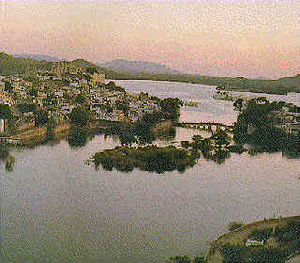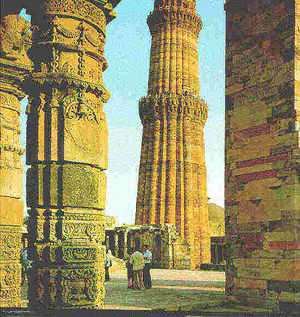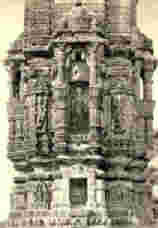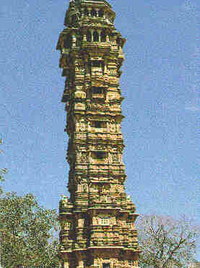Rajput Resistance to Islamist Aggression
By Shri Sudheer Birodkar
Rajputs were kshatriya warriors who ruled Northern India during the Muslim rule. In spite of the Muslim rule up to Punjab, the Rajputs gained control of the heart of North India. They trace their ancestry to Bappa Rawal - the legendary founder of the Rajputs who is said to have lived in the 8th century. The Rajputs (from Raj-Putra i.e. prince) were a brave and chivalrous group.
The Rajputs, till the 10th century, were mostly local feudal lords holding the status of revenue collectors for their Gurjara-Pratihara overlords. They asserted themselves as independent rulers after the Ghaznavid storm had blown over, and took over the earlier kingdoms of the Gurjara-Pratiharas. The main Rajput kingdoms in the 11th and 12th centuries were that of the Cahamanas (Chouhans) in East Punjab, Northern Rajasthan and Delhi, the Gahadwalas (Rathods) in the Ganges valley (covering the modern-day state of Uttar Pradesh in India), the Paramaras from Malwa in Central India and the Tomaras from Gwalior. The most powerful kingdoms, Chouhans and the Rathods, were incessantly at war with each other when the Muslim raiders re-appeared in 1191 C.E.
The Gahadwalas (Rathods)[edit]
The founder of the Gahadwala line was Govindchandra Gahadwala. He was an astute ruler and ruled from Kannauj. Most of North India, including the university town of Nalanda was a part of his kingdom. He stoutly defended his kingdom from further Muslims incursions which he financed through a tax called the Turushka Danda (i.e. tax to fight the Turushkas or Turks). His grandson, Jaichandra Gahadwala (Rathod), played a tragic role by supporting the Islamic invasions.
The Cahamanas (Chouhans)[edit]
In Jaichandra's days, a rival Rajput clan had established itself in Delhi (Pithoragarh) which was ruled by Prithviraj Chouhan, a romantic, chivalrous and a fearless king. After ceaseless military campaigns, Pritiviraj extended his original kingdom of Sambhar (Shakambara) to Rajasthan, Gujarat, and Eastern Punjab. He ruled from his twin capitals at Delhi and Ajmer. His fast rise caught the envy of the then powerful ruler Jaichandra Gahadwala and there was a lot of ill-feeling between the two.
Prithiviraj's Love for Sanyogita - Jaichandra's Daughter[edit]
The story of Prithviraj's bold exploits spread far and wide in the country and he was the center of much discussion in the circle of the nobility. Sanyogita, the daughter of Jaichandra Gahadwala fell secretly in love with Prithiviraj and she started a secret poetic correspondence with him. Her father got wind of this and arranged a Swayamwara (a ceremony where a bride can select her husband from the assembled princes. She had the right to garland any prince and she became his queen. This is an ancient Hindu custom among Royalty). Jaichandra invited all the big and small princes of the country to Kannauj for the royal Swayamwara but deliberately ignored Prithiviraj. To add insult to injury, he even made a statue of Prithiviraj and kept him as a dwarpala (doorman).
The Elopement of Sanyogita with Prithviraj[edit]
Prithviraj got to know of this and he confided his plans to his lover. On the said day, Sanyogita bypassed all the princes and garland the statue of Pritiviraj at the door. Prithiviraj who was hiding behind the statue, also in the garb of a doorman, whisked Sanyogita away and put her up on his steed to make a fast getaway to his capital at Delhi.
Jaichandra and his army gave earnest chase and in the resultant string of battles between the two kingdoms fought between 1189 and 1190, both of them suffered heavily. While this drama was being enacted, another ruler also named Mahmud from Ghori in Afghanistan had grown powerful and had captured Ghazni and subsequently attacked the Ghaznavid Governor of Punjab and defeated him. The kingdom of Mahmud Ghori now stretched up to the domains of Prithiviraj Chouhan. A clash was inevitable.
The 1st Battle of Tarain 1191 C.E. - Victory of Prithiviraj Chouhan[edit]
Mahmud Ghori threw the gauntlet by laying siege to the fortress of Bhatinda in East Punjab which was on the frontier of Prithiviraj's domains. Prithviraj's appeal for help from his father-in-law was scornfully rejected. Undaunted, Prithviraj marched on to Bhatinda and met his enemy at Tarain near the ancient town of Thanesar. In face of the persistent Rajput attacks, the battle was won as the Muslim army broke ranks and fled leaving their general Mahmud Ghori as a prisoner in Pritiviraj's hands.
Mahmud Ghori was brought in chains to Pithoragarh - Prithviraj's capital and he begged his victor for mercy and release. Prithviraj's ministers advised against pardoning the aggressor. But the chivalrous and valiant Prithviraj thought otherwise and respectfully released the vanquished Ghori.
The 2nd Battle of Tarain 1192 C.E. - Defeat of Prithiviraj Chouhan[edit]
The very next year Prithiviraj's gesture was repaid by Ghori who re-attacked Prithiviraj with a stronger army and defeated him by attacking the Rajput army before daybreak. The defeated Prithiviraj was pursued up to his capital and he was taken as a captive to Ghor in Afghanistan in chains.
The Blinding of Prithviraj[edit]
As a prisoner in Ghor he was presented before Mahmud, where he looked Ghori straight into the eye. Ghori ordered him to lower his eyes, whereupon a defiant Prithiviraj scornfully told him how he had treated Ghori as a prisoner and said that the eyelids of a Rajputs eyes are lowered only in death. On hearing this, Ghori ordered that Prithviraj's eyes be burnt with red hot iron rods.
Prithiviraj was regularly brought to the court to be taunted by Ghori and his courtiers. In those days Prithiviraj was joined by his former biographer Chand Bardai, who had composed a ballad-biography on Pritiviraj in the name of Prithviraj Raso (Songs of Prithviraj). Chand Bardai told Prithiviraj, that he should avenge Ghori's betrayal and daily insults.
The Blind Prithviraj Avenges the Injustice done to him[edit]
The two got an opportunity when Ghori announced a game of Archery. On the advice of Chand Bardai, Prithviraj, who was then at court said he would also like to participate. On hearing his suggestion, the courtiers guffawed at him and he was taunted by Ghori as how could a blind participate. Whereupon, Prithiviraj told Mahmud Ghori to order him to shoot and he would reach his target.
Ghori became suspicious and asked Prithviraj why he wanted Ghori himself to order and not anyone else. On behlaf of Prithiviraj, Chand Bardai told Ghori that he as a king would not accept orders from anyone other than a king. On the said day, Ghori's ordered Prithviraj to shoot, we are told Prithiviraj turned in the direction of the voice and struck Ghori dead with his arrow. This event is described by Chand Bardai in the couplet,
Dus kadam aggey, bees kadam daey, baitha hai Sultan. Ab mat chuko Chouhan, chala do apna baan. (Ten feet ahead of you and twenty feet to your right, is seated the Sultan, do not now miss him Chouhan, release your baan - arrow)
Establishment of Muslim Rule in Delhi and the Ganges Valley[edit]
But before his death at the hands of Pritiviraj Chouhan, Mahmud Ghori had once more attacked India and defeated Jaichandra Gahadwala at the battle of Chandwar in 1194 and captured Kannauj. The Rajput princes had refused to unite and had gone down one after another leaving the field open to the Muslim Aggressor, who now established himself in the heart of North India by 1194 C.E. Mahmud Ghori, himself did not settle in India, but he left his slave named Kutub-ud-din Aibak to rule by proxy. Kutub-ud-Din Aibak, asserted his independence soon after Mahmud Ghori's death in Afghanistan and formed his own dynasty - the Slave Dynasty or the Gulam Sultanate. The word Gulam occurs frequently among Muslims both as a first name and a family name. This indicates that many of them descended from slaves captured from the subjugated people.
Thus in the period from 715 C.E. to 1194 C.E. we see the gradual establishment of Muslim rule over all parts of North India, which in the following 120 years spreads itself over the whole of India with the campaign of Malik Kafur, the general of Alla-ud-din Khilji in 1324 C.E. overrunning the kingdoms of the Yadavas at Devagiri in Maharashtra, the Kakatiyas at Warangal in Andhra, the Hoysalas at Belur-Halebid in Karnataka and the Pandyas at Madurai in Tamil Nadu. This invasion marked the eclipse of Hindu sovereignty for the next 753 years from 1194 C.E. till 1947 C.E.
Kutub-ud-Din Aibak built the Kutub Minar as a symbol of his victory. He used the columns from destroyed Hindu and Jain temples from the Pithoragarh complex to build the Minar. Pithoragarh was the capital of Prithviraj Chauhan - the last Hindu ruler of Delhi. The damaged motifs on the pillars surrounding the Kutub Minar show clear Hindu origins, a testimony to the vandalism of the Muslim Aggressors.
The Rajput Resistance to Muslim Rule - Man Singh Tomar[edit]
In spite of the establishment of Muslim rule in the former kindoms of Prithiviraj Chauhan and Jaichand Rathod, the Muslim invaders could never overrun the entire country. The Rajput dynasties like the Tomaras of Gwalior and the Ranas of Mewad still continued to rule central India. One such Rajput ruler,Man Singh Tomar the king of Gwalior, put up a stout resistance to the Lodis and he succeeded in halting the Muslim ruler Sikandar Lodi's southward march at Gwalior. While the Tomaras of Gwalior held back the Muslims from advancing into Malwa, the Ranas of Mewad held up the banner of Indian independence from Mewad in those trying times of Muslim aggression in India. In South Rajasthan especially, the Rajputs had defiantly preserved their writ by resisting the Delhi Sultans.
The Story of Rani Padmini[edit]
In the 12th and 13th centuries, the Sultanate of Delhi was nevertheless growing in power. The Sultans made repeated attack on Mewad on one pretext or the other. Here we may recollect the story of Rani Padmini who was the pretext for Allah-ud-din Khilji's attack on Chittod. In those days Chittod was under the Rule of King Ratansen, a brave and noble warrior-king. Musician named Raghav Chetan in his court was banished from the kingdom for his evil sorcery. Raghav Chetan made his way towards Delhi and incited the Sultan of Delhi Ala-ud-din Khilji to attack Chittod by telling of Rani Padmini’s beauty.
But to his dismay, on reaching Chittod, Ala-ud-din found the fort to be heavily defended. Desperate to have a look at the legendary beauty of Padmini, he sent word to King Ratansen that he looked upon Padmini as his sister and wanted to meet her. On hearing this, the unsuspecting Ratansen asked Padmini to see the 'brother'. But Padmini was more wise and refused to meet the lustful Sultan personally.
But on being persuaded she consented to allow Ala-ud-din to see her only in a mirror. On the word being sent to Ala-ud-din that Padmini would see him he came to the fort with his selected his best warriors who secretly made a careful examination of the fort's defenses on their way to the Palace.
On seeing Padmini, the lustful 'brother' decided that he should secure Padmini for himself. While returning to his camp, Ala-ud-din was accompanied for some way by King Ratansen. Taking this opportunity, the wily Sultan treacherously kidnapped Ratansen and took him as a prisoner into his camp.
Ala-ud-din showed his true colors and demanded that Padmini be given to him in return for Ratnanen’s liberty.
The Rajput generals decided to beast the Sultan at his own game and sent back a word that Padmini would be given to Ala-ud-din the next morning. On the following day at the crack of dawn, one hundred and fifty palanquins (covered cases in which royal ladies were carried in medieval times) left the fort and made their way towards Ala-ud-din's camps. The palanquins stopped before the tent where king Ratnasen was being held prisoner. Fully armed soldiers came out of palanquins and quickly freed Ratansen and galloped away towards Chittod on horses grabbed from Ala-ud-din's stables.
On hearing that his designs had been frustrated, the lustful Sultan was furious and ordered his army to storm Chittod. But hard as they tried the Sultans army could not break into the fort. Then Ala-ud-din decided to lay siege to the fort. The siege was a long drawn one and gradually supplies within the fort were depleted. Finally King Ratnasen gave orders that the Rajputs would open the gates and fight to finish with the besieging troops. On hearing of this decision, Padmini decided that with their men-folk going into the unequal struggle with the Sultan's army in which they were sure to perish, the women of Chittod had either to commit suicides or face dishonor at the hands of the victorious enemy.
The choice was in favor of suicide through Jauhar. A huge pyre was lit and followed by their queen all the women of Chittod jumped into the flames. With their womenfolk dead, the men of Chittod had nothing to live for. Their charged out of the fort and fought on furiously with the vastly powerful array of the Sultan, till all of them perished. After this Pyrrhic victory the Sultan's troops entered the fort only to be confronted with ashes and burnt bones of the women.
These women who committed Jauhar had to perish but their memory has been kept alive till today by bards and songs which glorify their act which was right in those days and circumstances. Thus a halo of honor is given to their supreme sacrifice.
Rana Kumbha[edit]
Rana Kumbha who ruled from Kumbhalgad also put up a stout resistence to Muslim incursions into Rajputana in the 14th century. His capital Kumbhalgad which is a formidable fortress in densely forested Aravalli Ranges facilitated his resistance to the Muslims. This was one of the few times when the Rajputs used guerrilla tactics against the Muslims.
The Resistance of Rana Sangram Singh (Rana Sanga)[edit]
The next chapter of Rajput resistance to Muslim aggression was in the year 1527 when the Timurid ruler Babar invaded India. Babar first struck at the ruler of Delhi, Ibrahim Lodi and defeated and killed Ibrahim Lodi at Panipat to capture Delhi. Babar next turned his attention to the most powerful Hindu Kingdom in North India, Chittod ruled by Rana Sangram Singh. The clash of the Rajput and Muslim armies took place at Sikri. The Rajputs fought bravely and many perished in the cannon fire which Babar was using. The battle of Sikri gave Babar his second victory in India and saw the establishment of the Mughal Dynasty (the last Muslim dynasty to rule India).
Rana Udai Singh[edit]
Despite the defeat of Rana Sangram Singh in the battle of Sikri, the resistance of the Ranas of Mewad to Muslim rule continued for the next 100 years. Rana Sangram Singh's son, Udai Singh continued his father's legacy of preserving the independence of Chittod from the Muslim invaders. The city of Udaipur in Mewad bears his name.

Maharana Pratap[edit]
Udai Singh's son was Maharana Pratap who led the Rajputs against Akbar's armies and preserved Rajput rule in Mewad. Rana Pratap was faced with the formidable challenge of renegade Rajput princes like Raja Todar Mal and Raja Man Singh who had joined forces with the Muslim rulers.
The Battle of Haldighati[edit]
In the Battle of Haldighati fought between Maharana Pratap and the Mughals, the Rajputs were not able to overcome the combined strength of the Mughals and the renegade Rajput princes who had played the role of traitors. But Maharana Pratap who was badly hurt in the battle, was saved by his wise horse Chetak, who took him in an unconscious state away from the battle scene. Although Maharana Pratap was not able to thwart the Muslims successfully, the saga of Rajput resistance to Muslim rule continued till the 17th century when the baton of the struggle for Indian Independence from Muslim tyranny was taken up by the upcoming power of the Marathas, who brought about an end to Muslim domination of India.
References[edit]
- Sudheer Birodkar, "A Hindu History: A Search for our Present History". Reprinted with permission.




